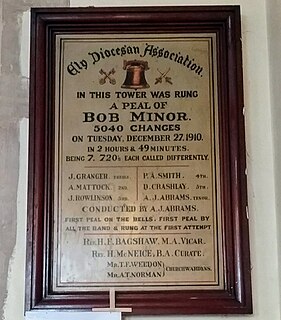
Change ringing is the art of ringing a set of tuned bells in a tightly controlled manner to produce precise variations in their successive striking sequences, known as "changes". This can be by method ringing in which the ringers commit to memory the rules for generating each change, or by call changes, where the ringers are instructed how to generate each change by instructions from a conductor. This creates a form of bell music which cannot be discerned as a conventional melody, but is a series of mathematical sequences.
Campanology is the scientific and musical study of bells. It encompasses the technology of bells – how they are founded, tuned, and rung – as well as the history, methods, and traditions of bellringing as an art.

A bell is a directly struck idiophone percussion instrument. Most bells have the shape of a hollow cup that when struck vibrates in a single strong strike tone, with its sides forming an efficient resonator. The strike may be made by an internal "clapper" or "uvula", an external hammer, or—in small bells—by a small loose sphere enclosed within the body of the bell.

A church bell in Christian architecture is a bell which is rung in a church for a variety of religious purposes, and can be heard outside the building. Traditionally they are used to call worshippers to the church for a communal service, and to announce the fixed times of daily Christian prayer, called the canonical hours, which number seven and are contained in breviaries. They are also rung on special occasions such as a wedding, or a funeral service. In some religious traditions they are used within the liturgy of the church service to signify to people that a particular part of the service has been reached. The ringing of church bells, in the Christian tradition, is also believed to drive out demons.
A handbell is a bell designed to be rung by hand. To ring a handbell, a ringer grasps the bell by its slightly flexible handle – traditionally made of leather, but often now made of plastic – and moves the arm to make the hinged clapper strike the inside of the bell. An individual handbell can be used simply as a signal to catch people's attention or summon them together, but handbells are also often heard in tuned sets.

A striking clock is a clock that sounds the hours audibly on a bell or gong. In 12-hour striking, used most commonly in striking clocks today, the clock strikes once at 1:00 A.M., twice at 2:00 A.M., continuing in this way up to twelve times at 12:00 mid-day, then starts again, striking once at 1:00 P.M., twice at 2:00 P.M., up to twelve times at 12:00 midnight.

An electric bell is a mechanical or electronic bell that functions by means of an electromagnet. When an electric current is applied, it produces a repetitive buzzing, clanging or ringing sound. Electromechanical bells have been widely used at railroad crossings, in telephones, fire and burglar alarms, as school bells, doorbells, and alarms in industrial plants, since the late 1800s, but they are now being widely replaced with electronic sounders. An electric bell consists of one or more electromagnets, made of a coil of insulated wire around an iron bar, which attract an iron strip armature with a clapper.
Method ringing is a form of change ringing in which the ringers commit to memory the rules for generating each change of sequence, and pairs of bells are affected. This creates a form of bell music which is continually changing, but which cannot be discerned as a conventional melody. It is a way of sounding continually changing mathematical permutations.

Russian Orthodox bell ringing has a history starting from the baptism of Rus in 988 and plays an important role in the traditions of the Russian Orthodox Church.

A "ring of bells" is the name bell ringers give to a set of bells hung for English full circle ringing. The term "peal of bells" is often used, though peal also refers to a change ringing performance of more than about 5,000 changes.

In campanology, a peal is the special name given to a specific type of performance of change ringing which meets certain exacting conditions for duration, complexity and quality.

A chime or set of chimes is a carillon-like instrument, i.e. a pitched percussion idiophone consisting of 22 or fewer cast bronze bells. Chimes are primarily played with a keyboard, but can also be played with an Ellacombe apparatus. Chimes are often automated, in the past with mechanical drums connected to clocks and in the present with electronic action. Bellfounders often did not attempt to tune chime bells to the same precision as carillon bells. Chimes are defined as specifically having fewer than 23 bells to distinguish them from the carillon. American chimes usually have one to one and a half diatonic octaves. According to a recent count, there are over 1,300 existing chimes found throughout the world. Almost all of them are located in the Netherlands and the United States, and other countries in Western Europe.
The North American Guild of Change Ringers, also known as the NAGCR, was founded in 1972 after the hanging of a ring of bells in the Washington National Cathedral in Washington, D.C., United States in 1964. The NAGCR has now grown and expanded to 52 bell towers across the United States and Canada as well as one mini-ring and 9 hand-bell groups with more than 500 members residing in North America. This organization performs the art of change ringing or method ringing, a form of campanology, in the towers and on hand-bells. This art uses mathematical sequences and patterns to change bell orders to carry out these sequences. Change ringing began in England in the 17th century.

A bell-ringer is a person who rings a bell, usually a church bell, by means of a rope or other mechanism.
The Bolognese bellringing system took shape during the Middle Ages, and was perfected in the 19th century. It is a form of full circle ringing.

Henry Thomas Ellacombe or Ellicombe (1790-1885), was an English divine and antiquary. He was the inventor of an apparatus to allow a single ringer to ring multiple bells.

Full circle ringing is a method of ringing a tower bell such that it swings in a complete circle from mouth upwards to mouth upwards and then back again repetitively.

Veronese bell ringing is a style of ringing church bells that developed around Verona, Italy from the eighteenth century. The bells are rung full circle, being held up by a rope and wheel until a note is required.

The Senior Memorial Chime, known more commonly as the Altgeld Chimes, is a 15-bell chime in Altgeld Hall Tower on the central campus of the University of Illinois at Urbana-Champaign, in Urbana, Illinois, United States.

The Duke's Tower, also known as Inveraray Bell Tower, is the detached bell tower of All Saints' Church, Inveraray, Argyll and Bute, Scotland. Standing 126 feet high on the shores of Loch Fyne, it is a landmark for miles and amongst the most notable bell towers in the United Kingdom. The tower was built as a memorial to members of the Clan Campbell who died in the First World War. It is Grade A listed by Historic Environment Scotland, the highest possible rating.














